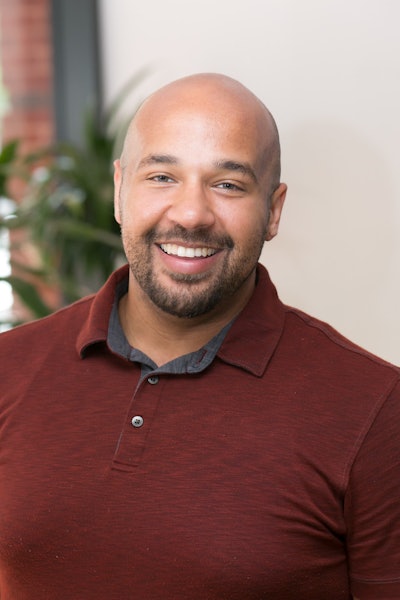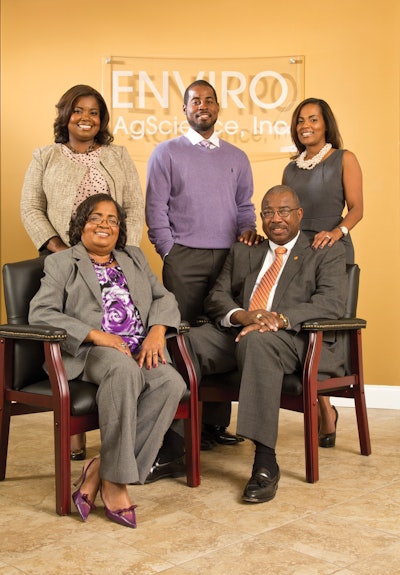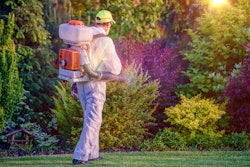 Duane Draughon is the owner of VizX Design Studios in Lisle, Illinois.
Duane Draughon is the owner of VizX Design Studios in Lisle, Illinois.Photo: Isabel Draughon
Like many landscapers’ introduction to the green industry, Duane Draughon started out mowing lawns at a young age as a way to keep busy.
After serving in the Marine Corps, his lawn care business continued to grow, and he began to design and install brick patios as well. But unlike many other landscapers, Draughon had to hire two white employees to serve as the face of his company.
“I hid behind the desk and drew all the designs, and there were a couple of times where a few of them didn’t even know that I was the owner,” Draughon says.
Draughon ran his business in Columbus, Ohio, for nine years and says it was always an uphill battle with both clients and suppliers. He says he would never show his face with suppliers because if he did, he was often accused of swindling or stealing bricks.
“If a client found out we owned the company, they would make up stuff on the Better Business Bureau,” he says. “It was almost they felt as if we tricked them because we didn’t tell them that I was the owner.”
Once when Draughon was moving the company’s office into a new space, the cops were called, and someone claimed they were robbing the place. After being harassed by the police for almost two years, Draughon decided to leave Ohio and move to Chicago.
“It was just too much,” he says. “And so, I had to walk away from a business that we started from $18 and took to $6 million in sales. I had to pretty much just walk away from it and start all over again.”
Now, Draughon owns VizX Design Studios based in Lisle, Illinois, and serves clients across the country creating unique outdoor living spaces.
After encouragement from a colleague, he finally started showing his face as the owner, putting his photo on the company website. Business dropped for almost a year, but Draughon continued working, proving his ability, and he says now it isn’t as much of an issue.
Dealing with bias
Draughon isn’t the only one who has had to deal with bias during their time in the green industry.
 Gaylan Williams
Gaylan Williams“I do not recall anything obvious, but sometimes there are certain systemic biases and issues we all deal with,” says Gaylan Williams, a senior associate with Dana Brown & Associates, Inc. based in New Orleans, Louisiana. “For example, when conducting site observations of a potential project site, I am usually confronted by security and such. My colleagues rarely have the same issues.”
Diane Jones Allen, director of landscape architecture at the University of Texas at Arlington College of Architecture, Planning and Public Affairs and a principal landscape architect of DesignJones, LLC, says that she hasn’t faced much opposition but often isn’t considered for certain types of work.
“There is a bias against minorities,” she says. “It is often assumed that we are less capable of handling the larger scale and technically challenging work.”
Jones Allen says that while communities of color are often excited to work with professionals of color, it can also be harder to work outside of those communities.
“One often gets pigeonholed or regulated to certain kinds of projects and denied access to high profile projects, even ones in minority communities, that can have a meaningful impact,” she says.
Dr. Louis Lynn, founder of ENVIRO AgScience, Inc., based in Columbia, South Carolina, says that thanks to his credentials of having a Ph.D. in horticulture, he has not had to deal bias within the industry. He says with some government contracts, other bidders assumed that Enviro AgScience only won the jobs because they were a black firm.
But after 34 years in business, Lynn says his multimillion-dollar company’s success speaks for itself. He focuses on making sure his company is eminently qualified and the fact that it is a minority-owned business is not the deciding factor.
“It was always my goal that I need to make sure I do it right,” Lynn says. “So that for the next minority firm that I paved the way for them.”
Thriving in the industry
Despite facing adversity at times, all four enjoy their work in the green industry and strive to make an impact.
For Williams, he has a passion for stormwater management, urban design, urban forestry and urban ecology and hopes to improve those aspects in his city.
His favorite part of working in the industry is “the fact that we improve the lives of the collective whole… all residents (no matter their income) can enjoy the public spaces we design and build.”
Lynn says his company strives to create above-industry standard services in both grounds maintenance and landscape design/install. His favorite aspect of the business has been creating new installations for public entities.
Meanwhile, Draughon has a love for designing outdoor living spaces and elevating how clients are treated and taken care of. His favorite part of working in the green industry is the creativity.
“I like being able to design and create and put it together,” Draughon says. “And even now it’s even better because what we’re designing are more elevated outdoor living spaces. So, we do a lot of modern styles with a lot of different materials. We’re really pushing the element of design on the exterior. So, I’m in love with it now.”
As the director of landscape architecture for the University of Texas at Arlington and being the principal landscape architect at DesignJones, Jones Allen is able to educate future landscape architects as well as help improve the environmental and cultural resiliency of local communities.
“I am interested in contributing to the creation of healthy and livable environments for all citizens, especially those in vulnerable communities,” she says. “My favorite part is seeing the results, whether that is completed open space that is being used and enjoyed, or an engagement effort that has resulted in power being placed in a community’s hands to shape their own environment.”
How to improve diversity
When it comes to African Americans being a minority in the landscaping industry, Draughon, Lynn and Jones Allen all agree that there is still considerable work to be done, while Williams believes it has been steadily improving since he entered the industry 16 years ago.
Each landscape professional has their own theory as to why African Americans make up such a small percentage in the field, as well as what they think must change in order to recruit and retain more minorities.
 Dr. Louis Lynn (seated on the right) has grown his business from 1985 and now his children handle the daily operations of ENVIRO AgScience, Inc.
Dr. Louis Lynn (seated on the right) has grown his business from 1985 and now his children handle the daily operations of ENVIRO AgScience, Inc.Photo: Black Enterprise
Draughon doesn’t think it is an industry issue but rather a nationwide problem of minorities simply never feeling welcome.
“We’re still fighting for position, day in day out,” Draughon says. “There’s just a lot of hidden roadblocks that our people go through. And I’m not complaining. I’m just saying that they exist.”
“I think it’s because of that affiliation to farming,” Lynn says. “And many African Americans have a negative connotation of farming from slavery.”
He says that while the current generation can’t relate to the farming aspect, there is a bias against manual labor, and it comes across as a non-success and a career of last choice. Lynn says that the industry needs to promote the wealth of opportunities the landscaping field holds aside from grass cutting, such as landscape architecture, irrigation and interiorscaping.
Lynn says it is important to appeal to this generation’s entrepreneurial spirit and interest in technology.
“We need to embrace technology for today’s workforce,” he says. “And that would capture both minority and non-rural kids, city kids that sometimes don’t want to go into it, and that would cut across race.”
Williams also thinks that the reluctance has to do with the perception of the industry, as African Americans who have the opportunity to pursue a higher education focus on careers with higher incomes.
“I feel the greatest concern is the exposure of the profession because professions in the green industry are not as flashy and well-respected as ‘doctor,’” Williams says. “Families, teachers, recruiters, counselors, etc. aren’t telling their kids to look into becoming a landscape architect, currently. We need that to change. Also, we need more equity and opportunity. The money does not trickle down, which is a problem with all professions.”
Jones Allen agrees that providing scholarships, internships and entry level positions for minorities and providing equity and opportunity for minority-owned landscape architecture firms would help improve diversity in the industry.
“I think that there has been little effort in making African American young people aware of the profession of landscape architecture, which is why there are such a low number of African American landscape architects as compared to building architects,” she says. “Often, vocabulary and language are used as barriers and the profession is described in ways that doesn’t connect to minorities and denies access to the discourse on ecology and the environment.”
“The language, discourse and representation of the profession must change to represent the diversity of the communities we work in,” Jones Allen says.









